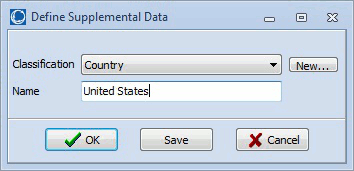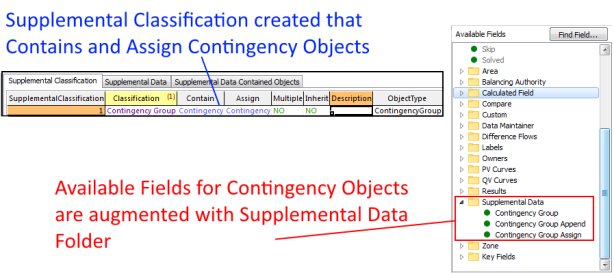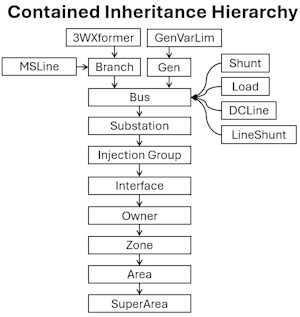Supplemental Data
Supplemental Data can be used to identify display objects that do not represent power system elements. User defined data types can be created and linked to display objects for use in filtering, dynamic formatting, Select by Criteria, and custom hints.
Supplemental Classification Definition
A Supplemental Classification is used to group Supplemental Data records into categories. As an example, if using Supplemental Data records to identify geographical borders, a Supplemental Classification could be Country. Each Supplemental Data record uses exactly one Supplemental Classification record.
Supplemental Classification records are defined by one key field: Classification. The remaining fields are all optionally specified and can be used for creating user-defined groups for reporting purposes.
|
Classification This field uniquely identifies the classification and cannot be blank. Contain Comma-delimited list of object types that are contained by Supplemental Data of this Classification. Assign Comma-delimited list of object types that can be assigned to Supplemental Data of this Classification. Multiple If YES, An object can belong to more than one Supplemental Data of this Classification. Inherit Set to YES to allow objects to inherit which supplemental data they are contained by from the model structure. For example, if a classification only is assigned buses, you may want a generator to inherit from its terminal bus which supplemental data it belongs to. The Inheritance hierarchy is as shown to the right. For example, a Gen will look to its Bus, then Substation, any Injection Group it belongs to, any interface, and so on. Once it finds a hierarchy level at which a supplemental data object has been assigned, then it will act as though it belongs to all Supplemental data objects at that level. Description This is just a string that is a user description of this Classification ObjectType Object Type: this is what will be used in AUX files as the field names to assign objects to a SupplementalData objects of this classification. It is the same as the classification name, but all spaces are removed and all of the following characters are replaced by an underscore \/:*?"<>',|. (so really just don't use these characters). |
|
Supplemental Data Definition
Supplemental data records are defined by two required key fields:
Classification
This is the Supplemental Classification Name. This field cannot be blank.
Name
This is a unique identifier used to further define the Classification. If using supplemental data records to identify geographical borders, the Name could be United States to go with a Classification of Country. This field cannot be blank.
In addition to the Classification and Name, geographic information, expressions, and custom strings, integers, and floating point values can be assigned to supplemental data records. This information can be entered in the Supplemental Data Case Information Display discussed below.
Displaying Supplemental Data Records
Supplemental Data records are displayed in the Supplemental Data Case Information Display found on the Model Explorer under Case Information and Auxiliary > Supplemental Data. This display consists of two tabs, Supplemental Classification and Supplemental Data. The table on the Supplemental Classification tab lists all of the Classifications that have been defined. The table on the Supplemental Data tab lists all of the Supplemental Data records that have been defined and provides the means for creating new Supplemental Data records AND Supplemental Classification records. Supplemental Classification records cannot be created under the Supplemental Classification tab.
Creating Supplemental Data Records
To create a new Supplemental Data record, from the Supplemental Data tab, right-click on the table and choose Insert from the local menu. The Define Supplemental Data dialog will open.

Either select an existing Classification from the drop-down box or create a new Classification by clicking New. (If creating a new Classification,another dialog box will open with a prompt for the Classification Name.) Type in a Name for the record. To create the record and close the dialog click OK. To create the record without closing the dialog click Save.To exit the dialog without creating the record click Cancel.
Assigning Objects to a Supplemental Data Definition
If Supplemental Classification objects are created to allow Contain and Assign types, then additional fields will appear on the related object types. The fields will appear in a folder called Supplemental Data and the field names will start with the Name of the Classification.
Classification Name
Lists all of the Supplemental Data to which an object belongs. Field is available for any object types that can be contained in or assigned to Supplemental Data.
Classification Name Append
Add the name of new Supplemental Data to which an object is assigned. Field is available for any object types that can be assigned to Supplemental Data.
Classification Name Assign
List the name of ALL Supplemental Data to which an object belongs. Field is available for any object types that can be assigned to Supplemental Data.
The following figure displays these relationships

Linking Display Objects to Supplemental Data
Display objects that cannot be linked to a power system element can be linked to a Supplemental Data record. These display objects include Background Line, Background Rectangle, Background Arc, Background Ellipse, Background Picture, Text, Case Information Memo, Oneline Field, Oneline Link, Document Link, and Memo Text.
Linking any of these objects to supplemental data must be done through the Display Explorer found under Onelines > All Display Objects. From the Explore tab, choose the display object type to link. If they are not already displayed, the Supplemental Data Classification and Supplemental Data Name fields must be added to the list of fields in the table. Simply enter the appropriate Classification and Name in the fields to link a particular display object to a Supplemental Data record.
Once a display object is linked to a supplemental data record, the information in the supplemental data record can be used to filter, dynamically format, Select by Criteria, and display custom hints for that display object.
Because there is no requirement to link display objects that cannot be linked to power system elements to supplemental data records, these objects will not be highlighted along with other unlinked elements when they are not linked to a supplemental data record.
Automatic Linking of Supplemental Data When Inserting Geographic Information
Background objects (lines and ellipses) created from inserting objects from borders included with Simulator and shapefiles can be linked automatically to supplemental data records.
When auto inserting borders included with Simulator, the option to Automatically link county and state borders to supplemental data needs to be checked for this to occur.
When inserting background objects from shapefiles, there are several options that need to be set for proper linking to supplemental data. These options are available on the Identify tab of the GIS Shapefile Data Dialog.
